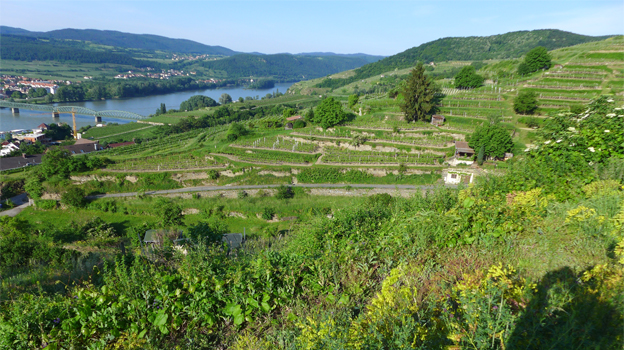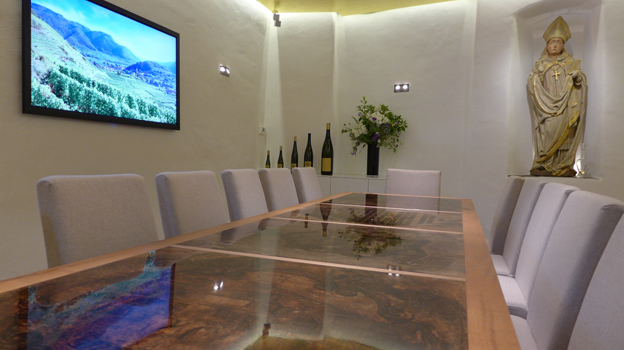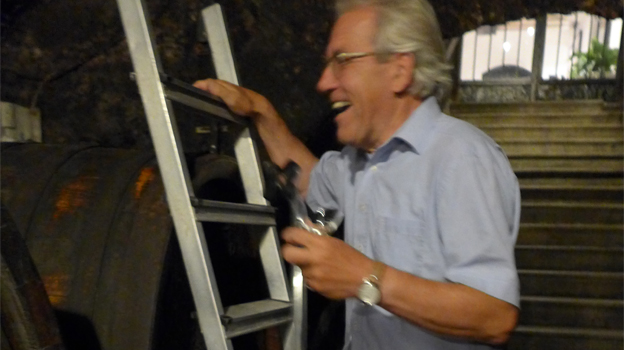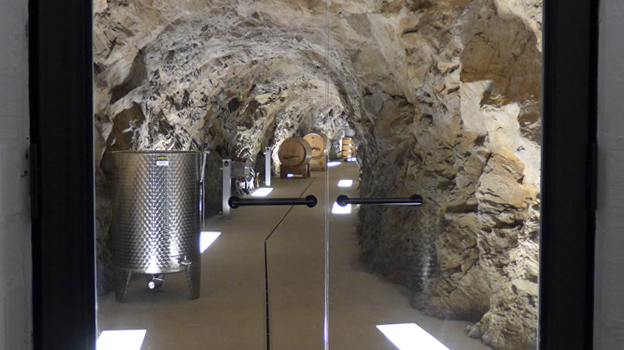Browse using the new Vinous website now. Launch →
Printed by, and for the sole use of . All rights reserved © 2015 Vinous Media
Austria’s 2015 Rieslings and Grüner Veltliners: Ripe and Ready
BY DAVID SCHILDKNECHT | FEBRUARY 23, 2017
Two thousand-fifteen, a stress-free vintage for growers, overflows with generous, lovely wines that belie mid-summer drought and record-setting heat.
A Bit of Perspective
The 2014 and 2015 growing seasons in Lower Austria’s Riesling and Grüner Veltliner growing sectors offer an irresistible opportunity to hold forth on the subject of vintage assessments. In 2014, Nature threw the book at growers, meteorologically speaking: ripeness was challenged by inopportune chill and record-setting rains that led to the agonizingly frustrating, labor-intensive harvest of a crop too small for its sale to even cover their costs. No wonder growers were still grimacing months later when asked to relate their experiences, by which time the popular press, and even too many of those who are professionally tasked with assessing new wines, had already pronounced the vintage a disaster. In 2015, on the other hand, everything fell into place. Following ample winter and spring precipitation, predominantly warm, dry weather promoted early sugar accumulation in an abundant crop that could be harvested largely at leisure. Small wonder, then, that growers could scarcely wipe the smiles from their faces and the press corps crowed about a Great Vintage.
What’s wrong with this picture? Well, nothing has yet been said about how the wines actually taste! This summer, Ilse Maier of the Geyerhof told me something I’d never heard from a grower but that couldn’t have been better-timed: “I keep a poker face and never volunteer my impressions of a vintage until the journalist or customer has first tasted the young wines. He or she probably has enough preconceptions already. I’m not about to add to them; and if they need to be corrected, I can only hope that the wines will accomplish this.”
I commenced my summer foray into Austria by visiting Hannes Hirsch, who turns out to have rendered some of the most exciting wines of 2015. At his invitation—not that I wouldn’t have asked—he opened full sets of 2013s and 2014s alongside. “If you had told me even a few months ago that any 2014 could have held its own in this company,” Hirsch exclaimed, “I’d have said ‘no way’!” Yet there they were: bright and shiny, rivetingly complex, although, to be sure, in an entirely different key from the 2015s and 2013s. I had to remind Hirsch that this outstanding performance by 2014 had in fact been my own prediction.
So before we both embark on my detailed survey of vintage 2015, dear reader, permit me to make two recommendations up-front. If I had to deprive myself of one vintage among these three, 2015 would be my pick. It is an excellent vintage with an abundance of lovely, lush, ripely fruity wines, many of which are far from lacking in animation and complexity, and a few of which are sensational. But 2015 doesn’t rival the consistent excitement of 2013. Meanwhile, unloved as it was in Austria thanks to horror-mongering early press, 2014 is that rare vintage from which, despite low yields, many of the most successful growers—not to mention many merchants—had wine left unsold more than a year after the harvest. So it’s not too late for those who have yet to discover the unique virtues of the best 2014 Rieslings and Grüner Veltliners from Lower Austria. What’s more, most of the hundred or so that I retasted this past summer and early autumn proved even more exciting than when tasted a year earlier.

Stein vineyards; from left to right, the Steiner Hund, Grillenparz and Goldberg, and in the distant right the vineyards of Braunsdorf, all coming in for renewed recognition thanks to new talents emerging in the Krems area.
A “Perfect” Growing Season and Its Wines
“Conditions were perfect in 2015: everything happened at the right time, leaving no wishes unfulfilled,” recapped an elated Willi Bründlmayer. “We had an ideal flowering, a lovely summer and an ideal harvest without excessive heat.” Peter Malberg testified to “the most uniform budding I’ve ever seen.” And Domäne Wachau director (and Master of Wine) Roman Horvath wryly remarked of the weather leading into harvest: “It was so beautiful, it was nearly kitschy.”
Can conditions be too good and the resulting crop too uniformly excellent? That question won’t sound daft to anyone who has followed the Rieslings and Grüner Veltliners of vintage 2005, or for that matter those who recall how Burgundy’s highly touted 1990 and 1995 Pinots evolved: uniform ripeness does not necessarily translate into real excitement. Bründlmayer himself compares 2015 with 1992, a year that Austrian wine lovers may well recall for its exceptionally warm, sunny summer but probably not for the Rieslings and Grüner Veltliners that hung through it—wines that were often generous to the point of being outsized and obvious. Especially in tasting through an abbreviated range of wines from growers whom I met at the 2016 VieVinum but who do not usually make my cut for annual visits, I was astonished how hard it sometimes was even to tell whether the abundantly fruity 2015 in my glass was a Riesling or a Grüner Veltliner. Sometimes, it seems, a bit of adversity builds character in wines, and perhaps more importantly forces the grower to harvest selectively, which most growers didn’t deem necessary in 2015. Too much homogeneity might limit complexity, and a harvest of everything that’s hanging might incorporate fruit from vines whose less desirable genetics would in a more challenging vintage have predestined them for rejection. Among that minority of growers who testified to widespread removal of botrytized bunches, several—Hirtzberger, Jamek and Knoll, for example—were extremely successful.

Hirtzberger Probierzimmer; the ancient pressoir just inside the Hirtzbergers’ doorway was recently remade into their first-ever tasting room, where you can monitor the terraced Singerriedel in real time.
Nor was the summer’s
dry, hot weather entirely benign. Depending on location and availability of
irrigation, some growers testified to serious vine stress during the height of
summer. “Ships couldn’t travel this stretch of the Danube, and at one point it
reached 38 degrees Celsius [just over 100 degrees F.],” noted Toni Bodenstein,
who had to stop irrigating in late July because Weissenkirchen’s source of
drinking water is too near that of its growers’ drip lines. Those unlucky
enough to have planted vines in the spring of 2015 or of 2014 risked serious
losses, and many in this situation trucked tanks of water to their young
vineyards and laboriously hand-irrigated to keep the vines alive.
Must weights were rising so rapidly in September that most growers elected to harvest early even by recent standards. As Bründlmayer testified, “In my 34 years in charge at our estate, this was the first year when we had picked all of our top sites by All Saints Day”—i.e., November 1. Factor in a later flowering than in most recent years and the likelihood that vines shut down periodically in response to mid-summer drought stress and, in most sectors, to the warmest July on record. “I’m not sure we would have had a harvest without irrigation,” remarked the Tegernseerhof’s Martin Mittelbach, echoing comments made by many of his colleagues. The upshot is surely that a significant share of fruit did not benefit from as long a ripening period as usual. Fortunately, late August rain jumpstarted any malingering vines. And as felicitous as autumn conditions on the whole were, growers who elected to prolong the harvest past the middle of October had to deal with the return of rain and, in some sectors, resultant botrytis.

Emmerich Knoll Sr.
If you favor the hypothesis shared by many outstanding growers that hanging fruit into a cold snap is critical to maximizing aromatic detail, focus, animation and finesse, that could explain why those traits are frequently lacking in 2015—a weakness especially noticeable when any given wine is compared with its 2013, and often also with its 2014, counterpart. Acid levels, while diminished in most cases by the prevalence of abnormally warm July and August nights, were still seldom less than adequate at top estates. The authorities permitted acidification, but rarely did I experience a wine that seemed to betray its grower having taken that measure. And for reasons that growers professed an inability to explain, acidity in certain sectors remained surprisingly high. On the whole, though, the 2015s tend toward a breadth and generosity that enhances their richness of fruit, even if the price is occasionally diminished precision or loss of vigor. And although phenolic rusticity seems occasionally to betray drought stress or slight fruit desiccation, it sometimes also supplies stimulating cut.
Riesling outperformed Grüner Veltliner at most estates, largely because of its superior acid retention and longer hang time, although in instances where picking was undertaken early so as to ensure alcoholic levity or preserve acidity, Riesling was at greater risk of underripe flavors. Roman Horvath places his 2015 results somewhere between those of 2011 and 2012 in character as well as quality, reflecting a far more conservative assessment of 2015’s potential than that voiced by many of his colleagues, and certainly than that which has prevailed in the press. I find the 2015s significantly finer than the 2011s and close to the 2012s and 2005s in personality, although 2015 differs on account of its significant minority of early-picked Rieslings that are only marginally ripe. On the whole, I would plan to enjoy the 2015s while I still have 2014s and especially 2013s left for subsequent consumption.
There was one horror story to recount in the course of 2015—namely a rare nighttime hailstorm of frightening ferocity that hit parts of the Kremstal, Kamptal and especially the Wagram on May 6. This was early enough, though, that to the surprise of most growers the vines recovered well, and the warm, precocious season managed in many cases to adequately ripen the eventual fruit of secondary buds. Even so, the affected sectors form an exception to this vintage’s generally generous yields. The authorities raised permissible yields in 2015 by 20%, ostensibly so that there would be a surplus available for supplemental purchases by those afflicted with hail. Toni Bodenstein explains that a 20% allowance has long been an available option, but to his knowledge 2015 is the first vintage in which it was put into effect. That vexed him, considering that a mutual yield agreement among growers in the Wachau has held since 1986, not to mention how abundant 2015 yields were destined to be except for those vineyards worst hit by the spring hail.

For three years, Markus Lang has been stealing weekends from his engineering job in Bavaria to return to his family’s wine growing roots in Krems-Stein. A former bomb shelter is now this cellar equipped expressly for long élevage and further described in my report.
Stylistic Smoke Signals
Two important recent trends have been underscored by vintage 2015, notwithstanding the ripeness, forward generosity and relative fullness of its wines vis-à-vis those of the two immediately preceding growing seasons. The first trend, which is becoming familiar from many parts of the wine world including ostensibly (or at least formerly) “cool climate” regions, is a preference for bottling lower-alcohol wines. Naturally that can be accomplished in part by higher yields or earlier picking, though arguably some 2015 Rieslings would have benefited flavor-wise if their growers had let the grapes hang a bit longer. Greater scrupulousness concerning the elimination of botrytized fruit in classic dry wines has also contributed significantly to the trend toward lower alcohol, although for most growers noble rot wasn’t a significant factor in 2015. The most important advances in moderating alcohol, though, involve managing one’s vines to achieve ripe flavors and complex aromatics at lower grape sugars, an accomplishment for which most biodynamic growers credit their specific viticultural regimen, and an objective toward which many other growers seem to be successfully striving.
Only a small share of Grüner Veltliners and virtually none of the Rieslings I tasted from 2015 cracked the 14% alcohol threshold, which would have been routinely and abundantly breeched had this growing season taken place between 1995 and 2010. This alcoholic restraint was probably well-timed, because even some 2015s that weigh in under 14% evince a bit of alcoholic warmth, quite possibly due to the low levels of buffering extract that prevail in nearly any vintage characterized by summer heat and drought.
Hand in hand with the aforementioned interest in moderating finished alcohols goes an increasing concern to maintain freshness. And in sunny, warm vintages like 2015, one nowadays increasingly hears growers saying “better a bit lower must weight and a bit better acid retention.” The F. X. Pichler winery, long associated with powerful, high-alcohol Smaragds, has under the direction of Lucas Pichler been among those endeavoring to preserve freshness and to moderate alcohol, in ways and with results discussed in detail in my introductions to the tasting notes I published on their 2014s and 2013s. Pichler is only the most conspicuous among leading members of the Vinea Wachau to illustrate this trend, and a number of relatively young estates not affiliated with either of Lower Austria’s prestigious grower organizations—including Harm, Lesehof Stagård and Veyder-Malberg—are generating superb wines notable for their modest alcohol.
The second trend that continues to gain momentum, greatly accelerated by the decision of Lower Austria’s Traditionsweingüter not to permit release of top single-vineyard wines until the end of the summer, is that of longer élevage. Agreeing as a group to hold off on releasing (or even, except in special circumstances, presenting) their young wines from top sites removes much of the competitive commercial pressure that many a member of the Traditionsweingüter doubtless previously felt to get his or her wines in bottle. Under the new arrangement, as my notes from June 2016 reflect, most members decided that even their generous 2015s would benefit from deferring bottling until July or August. Many distinguished members of the Vinea Wachau as well as unaffiliated Lower Austria growers also postponed bottling. To appreciate what a sea change this represents, one has to consider that with the exception of a small minority among self-described connoisseurs, Austrian consumers have for decades been enamored with the idea of drinking the youngest possible wine, and have been suspicious of any wine that isn’t. Extended élevage also offers opportunities for enhanced appreciation of the distinctive characteristics conveyed by each of an ever-expanding range of fermentation and storage vessels, ranging from oak and acacia casks of diverse sizes through the sophisticated shapes of today’s refined concrete tanks, to earthenware or terracotta crocks and clay amphorae (even, in one instance, a lidded tub of granite!), all of which you will find being employed by growers covered in this article.

Urban Stagård has every reason to be pleased with how this 2015 Braunsdorfer “Zwillinge” – named in honor of his twins – turned out. It’s one of several Rieslings that he has fermented with a significant share of whole berries in antique ceramic crocks.
In This Report
This article offers my impressions based on visits to 56 estates in June of 2016, supplemented by more than two dozen tastings with other growers at Vienna’s biennial VieVinum exposition and by opportunities to revisit many wines in late summer or autumn. Tasting notes on those wines that were last tasted from tank or cask—whose numbers increase each year—are as usual accompanied by point spreads rather than by a single numerical rating. What few wines I report on here from vintages other than 2015 represent ones that I did not have the opportunity to assess before this past summer. Some of these were only released in late 2016, and others are from growers whom I visited in 2016 for the first time or for the first time in several years. As usual, notes on wines that I thought justified a score of less than 87 points are published only in instances where they nevertheless represent good value, or where I thought it important to publicize my concerns about a particular wine.
Nearly all of my grower introductions in this report are brief and focus solely on vintage 2015 or on very recent important developments at the estate in question. I refer those readers seeking further detail on estate histories, personalities, vineyards and methodologies to the extended introductions that I supplied for those estates covered in my reports focused on vintages 2013 and 2014. Where I make an exception and offer a more extensive introduction in the current article, that is because I did not incorporate those growers into my earlier reports on vintages 2013 and 2014.
You Might Also Enjoy
2014 on the Mosel: Man Bats Last, David Schildknecht November 2016
2014 Mosel: A Hard But Often Rewarding Harvest, David Schildknecht October 2016
Rescuing Ruwer Riesling in 2014 ... and Beyond, David Schildknecht September 2016
The Saar 2014: Stress for Success, David Schildknecht September 2016
2014 Germany: Riesling Resists Rain on the Rhine, David Schildknecht May 2016
Austria 2014: A Catastrophe? Not Qualitatively!, David Schildknecht February 2016
2013: A Great Vintage for Austrian Riesling and Grüner Veltliner, David Schildknecht November 2015
Show all the wines (sorted by score)
- Allram
- Alzinger
- Artur Toifl
- Barbara Öhlzelt
- Bernhard Ott
- Birgit Eichinger
- Bründlmayer
- Buchegger
- Christ
- Christoph Edelbauer
- Domäne Wachau
- Ebner-Ebenauer
- Edlmoser
- Emmerich Knoll
- Erich Berger
- Franz Hirtzberger
- Fritz Salomon - Gut Oberstockstall
- Fuchs und Hase
- Geyerhof
- Gritsch Mauritiushof
- HarmWein
- Herbert Zillinger
- Hiedler
- Hirsch
- H. & M. Hofer
- HM Lang
- Högl
- Ingrid Groiss
- Jäger
- Josef Ehmoser
- Josef Jamek
- Josef Schmid
- Jurtschitsch
- Jutta Ambrositsch
- Karl Stierschneider – Kartäuserhof
- Kurt Angerer
- Leindl
- Lesehof Stagård
- Loimer
- Malat
- Mantlerhof
- Martin & Anna Arndorfer
- Martin Diwald
- Martin Muthenthaler
- Martin Obenaus
- Mayer am Pfarrplatz
- MG Vom Sol - Michael Gindl
- Neumayer
- Nigl
- Nikolaihof Wachau
- Peter Schweiger
- Pichler-Krutzler
- Pollerhof
- Prager
- Prechtl
- Proidl
- Pur
- Quantum Winery
- Rainer Wess
- R. & A. Pfaffl
- Rudi Pichler
- Salomon – Undhof
- Schloss Gobelsburg
- Schreibeis – Keller am Gaisberg
- Schwarzböck
- Sepp Moser
- Setzer
- Söllner
- Stadt Krems
- Steininger
- Stift Göttweig
- Tegernseerhof
- Thomas Leithner
- Tom Dockner
- Veyder-Malberg
- Walter Wien
- Weinbau Landsteiner
- Weinberghof Fritsch
- Weingut F. X. Pichler
- Weinhofmeisterei Hirtzberger
- Wieninger
- Zöch – bis am Berg
